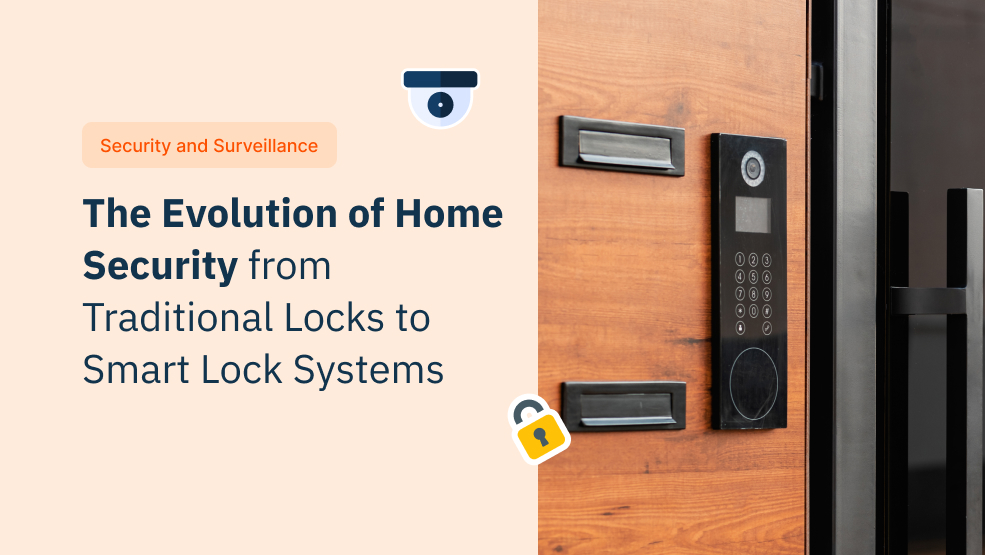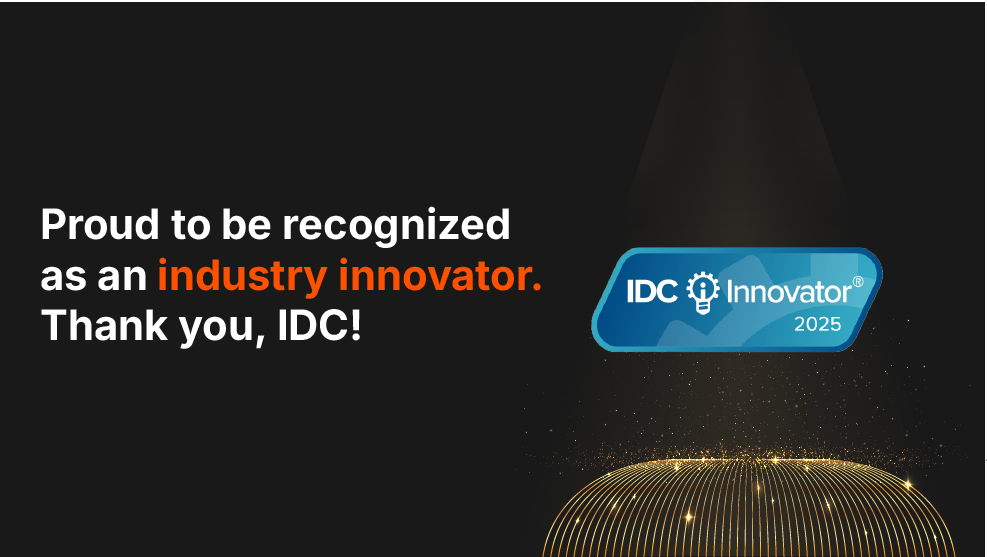In 2024, the global smart home security market was valued at a staggering $32.5 billion, and the industry has seen tremendous growth in recent years, with the future only looking brighter. It is estimated that the size of the smart home security market will continue to expand significantly over the next few years. By 2029, the market is expected to reach nearly $62 billion in value, almost doubling in size from current levels. Home security has been one of the main concerns for homeowners and residents throughout history. In the earliest days, simple wooden locks and bars were used to deter would-be intruders from gaining access to one’s dwelling. As communities grew and threats became more sophisticated, lock mechanisms advanced, transitioning from basic pin tumblers to more complex combination locks. For centuries, the classic metal key and tumbler system represented the height of home security technology.
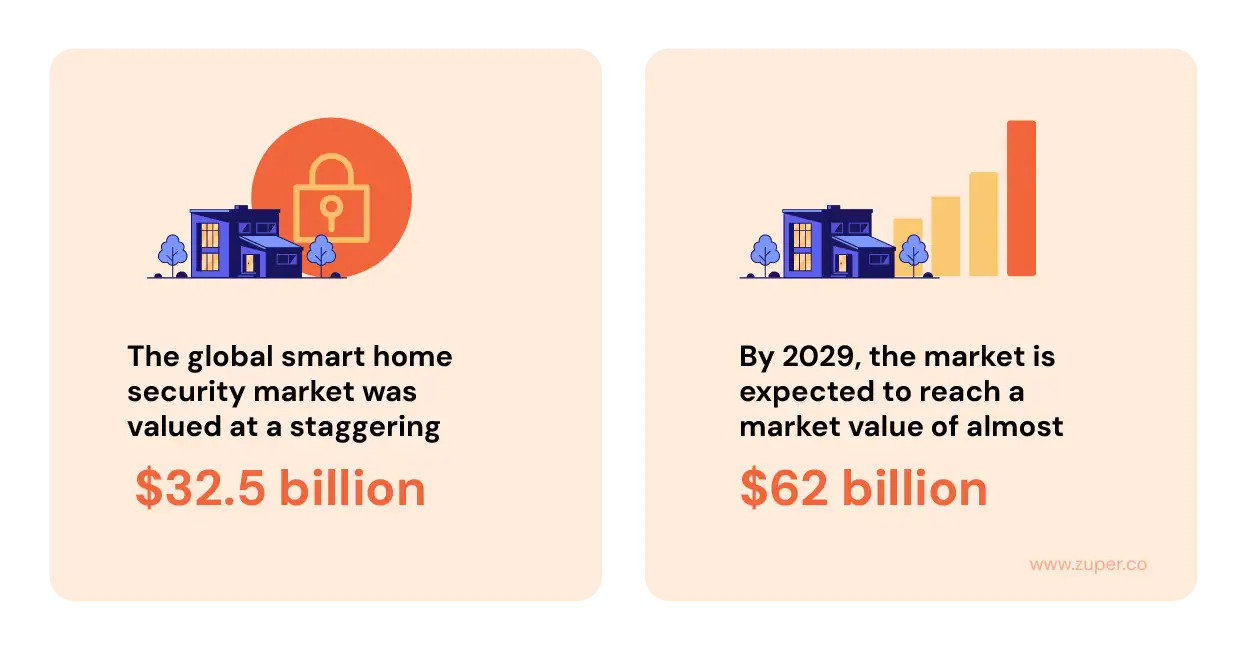
However, as the modern era ushered in new dangers, the limitations of traditional lock-and-key approaches became increasingly apparent. Burglars developed methods to pick locks or simply break down doors and windows. Homeowners sought greater peace of mind after the emergence of electronic access controls, alarm systems, and, eventually, sophisticated smart home security solutions. Biometric technologies like fingerprint and facial recognition add a layer of personalized protection. Wireless, app-enabled locks allowed residents to monitor and control access remotely, whether at work, running errands, or enjoying a long-awaited vacation with the help of state-of-the-art security and surveillance.
The importance of robust home security cannot be overstated, especially in today’s state of events. When leaving for a trip, homeowners must be confident that their residence is safeguarded against break-ins, theft, and vandalism. The ability to lock up, arm the alarm, and receive instant notifications provides invaluable reassurance. Similarly, arriving home late at night requires the assurance that one’s family and possessions are secure. Smart lighting, cameras, and automated locks should work in combination to deter potential threats. As our lifestyles become increasingly mobile and tech-driven, the evolution of home security has proven essential to preserving our safety, privacy, and peace of mind. From the earliest wooden bars to the cutting-edge of smart home technology, the need to protect one’s dwelling has remained a constant throughout human history.
The rise of electronic security systems
As the limitations of traditional mechanical locks became more apparent, the home security industry sought to adapt to the changing landscape. The advent of electronic access control systems represented a significant evolution in locking technology. These electronic locks provide enhanced security features like programmable access rights, audit trails, and remote management by incorporating keypads, keycards, and even biometric authentication methods. The introduction of wireless connectivity and smartphone integration further expanded electronic security capabilities, enabling homeowners to monitor and control access from anywhere. This transition marked a pivotal moment in safeguarding homes and properties against an ever-shifting array of threats. Let’s explore the capabilities of wired and wireless alarm systems below.
Benefits of electronic security systems
The evolution from traditional mechanical locks to advanced electronic security systems has brought a transformative shift in how homeowners safeguard their properties. Electronic access control solutions offer a multitude of advantages over classic key-and-tumbler locks. At the most fundamental level, electronic locks provide heightened security by eliminating the vulnerabilities associated with physical keys – electronic locks cannot be easily copied, lost, or stolen, effectively closing off one of the primary entry points exploited by burglars. Many electronic systems also incorporate sophisticated authentication methods, such as keypad codes, proximity cards, and even biometric scanners, making it exponentially harder for unauthorized individuals to gain entry.
Beyond enhanced access control, electronic security systems unlock a new realm of features designed to give homeowners unparalleled protection and convenience. Wireless connectivity and mobile app integration allow users to remotely monitor, control, and receive instant alerts about their home’s security status. Homeowners can lock or unlock doors, arm the alarm, and review video footage from anywhere, providing unmatched peace of mind when they are away from their property. Electronic systems can seamlessly integrate with other smart home technologies, like lighting, climate control, and surveillance cameras, creating a cohesive ecosystem to safeguard residents.
Convenience is another key advantage of electronic security. Keyless entry options, such as keypads and smartphone-based unlocking, eliminate the need to carry bulky key rings and the hassle of managing physical keys. This streamlined access control proves especially beneficial for families, guests, and service providers requiring temporary or recurring entry. The transition from traditional mechanical locks to cutting-edge electronic security systems represents a transformative leap in home protection, merging heightened security with unprecedented remote access and smart home integration. While both wired and wireless electronic security solutions offer these impressive benefits, the choice between the two approaches requires careful consideration of factors such as installation complexity, scalability, and reliability. As homeowners seek to future-proof their properties against evolving threats, understanding the nuances of these electronic security systems becomes increasingly crucial.
Wired alarm systems
Wired alarm systems represent one of the earliest electronic home security solutions. These systems rely on a network of sensors that are hardwired back to a central control panel, including motion detectors, door and window contacts, and glass break detectors. When triggered, the control panel sounds a loud siren and can also alert a professional monitoring service. While effective at deterring and detecting intrusions, wired alarm systems face some notable limitations. The complexity of installation, which often requires drilling through walls, can be inconvenient and costly for homeowners. Additionally, these systems remain vulnerable to false alarms and unnecessary disruptions triggered by pets, user error, or technical malfunctions.
Wireless alarm systems
The limitations of traditional wired alarm systems paved the way for the emergence of wireless home security alternatives. Wireless alarm components, such as sensors and keypads, communicate with the control panel through radio frequency or cellular signals, eliminating the need for complex wiring and providing several key benefits. Installation is significantly more straightforward and less invasive, allowing homeowners to set up and expand their security coverage as needed quickly. Wireless systems also tend to be more flexible and scalable, enabling the integration of additional sensors, cameras, and smart home devices over time. Furthermore, wireless alarms are less susceptible to failure from wiring malfunctions or tampering. These advantages have driven widespread consumer adoption of security solutions based on wireless technologies.
The smart lock revolution
Smart locks are at the forefront of the evolving home security landscape; the global smart lock market peaked at $33.6 billion in 2022 and is set to expand at a CAGR of 19.68%, reaching 9,019 million by 2031. Advanced electronic locking devices leverage connected technologies and provide unprecedented control and convenience. Smart locks go beyond basic keypad or keycard access, enabling homeowners to unlock their doors remotely using a smartphone app. These innovative systems integrate seamlessly with mobile devices, allowing users to monitor lock status, grant temporary access to guests, and receive real-time notifications, all from the palm of their hand. By combining keyless entry, remote access, and smart home integration, smart locks represent a transformative leap in home security, empowering residents with unprecedented protection and usability.
Smart locks leverage wireless communication protocols to facilitate advanced connectivity and remote access capabilities. Bluetooth has emerged as a common standard, enabling smart locks to pair directly with homeowners’ smartphones for keyless entry and app-based control. Bluetooth’s low-power, short-range nature makes it a power-efficient choice, though it limits the range over which locks can be monitored and managed remotely. In contrast, Wi-Fi-enabled smart locks can leverage a home’s existing internet network to provide seamless remote access from anywhere. However, this increased connectivity can also make them more vulnerable to cyber threats if they are not adequately secured.
Other wireless protocols like Zigbee and Z-Wave have also found applications in the smart lock space, catering to homeowners seeking to integrate their locks into broader smart home ecosystems. These mesh network standards allow locks to communicate easily and be controlled by a central hub, facilitating whole-home automation. However, relying on a dedicated smart home controller can add complexity for some users. Emerging technologies like Thread and Matter aim to unify the fragmented smart home landscape, potentially paving the way for more interoperable, streamlined smart lock integration. As you weigh the connectivity options, carefully considering the tradeoffs between range, security, and interoperability will be crucial in selecting the right smart lock solution for your home.
Benefits of smart locks
The capabilities of smart lock technology extend beyond simple keyless entry. Today’s advanced models incorporate biometric authentication methods, such as fingerprint scanners and facial recognition. Granting access based on unique physical characteristics is a significant security enhancement over traditional passcodes. Something equally valuable is the ability to manage user access permissions remotely, allowing homeowners to grant temporary entry to guests, service providers, or family members without having to physically hand over a key. The activity logging features also provide an audit trail, enabling users to track who has entered the home and at what time.
Smart locks further differentiate themselves through seamless voice control integration, empowering residents to lock, unlock, and check the status of their doors using simple voice commands via digital assistants like Alexa and Google Assistant. Today’s smart locks have radically transformed the home security landscape by blending heightened security, customizable access management, and convenient smart home integration.
Smart lock security considerations
While smart locks offer remarkable convenience and enhanced security features, homeowners must also be mindful of their potential vulnerabilities. As with any connected device, smart locks are susceptible to hacking attempts if they are not adequately secured. Choosing reputable brands that prioritize robust encryption and regular software updates is crucial to stay ahead of evolving cyber threats. Proactive measures like enabling two-factor authentication and changing default passwords can further mitigate these risks. Additionally, the reliance on batteries means smart lock owners must have a plan in place for power outages or dead batteries to ensure uninterrupted access to their homes. Investing in models with backup battery options can provide that added peace of mind. Homeowners can optimize the protection and convenience these systems offer without compromising the safety of their property and loved ones. Balancing the transformative benefits of smart lock technology with a keen awareness of security best practices will help you make the most of this technology.
Integrating a smart home system for home security
The seamless integration of smart locks into broader smart home ecosystems has become an increasingly prominent trend, unlocking a new realm of security advantages. Connecting locks with other intelligent devices like cameras, motion sensors, and lighting allows homeowners to create a comprehensive, cohesive system to safeguard their properties. This holistic approach allows automated actions, such as lights turning on when a door is unlocked or cameras activating upon movement detection. Furthermore, smart home hubs’ centralized control and monitoring enable residents to oversee their home’s security status from a single, convenient interface. As smart home technologies continue to advance, the opportunities to enhance residential protection through intelligent integration will only continue to grow.
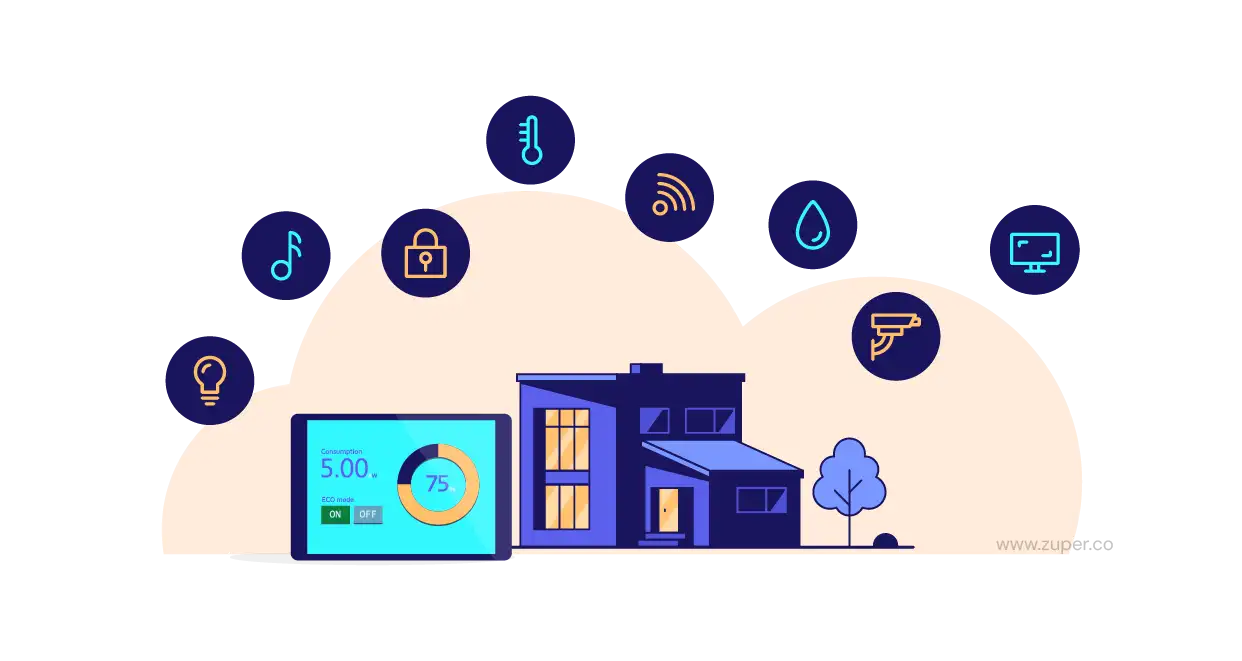
The true power of smart locks is unlocked when they seamlessly integrate into a broader smart home ecosystem. Homeowners can create a comprehensive security solution by connecting smart locks with other intelligent devices like security cameras, motion sensors, smart lighting, and climate control systems. This holistic approach allows for automated actions, such as cameras activating when a door is unlocked or lights turning on to deter potential intruders. Furthermore, centralized control through a smart home hub enables residents to monitor their property’s security status from a single, convenient interface, regardless of whether they’re at home or away. As smart home technologies advance, the opportunities to improve residential protection through intelligent integration will continue to grow.
Technological influence on home security
As home security technology continues to evolve, the landscape is poised for even more transformative advancements in the years ahead. Artificial intelligence and machine learning are set to play an increasingly pivotal role, empowering smart home systems to detect anomalies and potential threats with greater accuracy. Biometric authentication methods are also expected to become more sophisticated, transitioning beyond fingerprints and facial recognition to incorporate innovative modalities like vein pattern scanning and behavioral analytics. The integration of wearable devices like smartwatches will enhance home security by enabling hands-free control and automated responses based on a resident’s proximity to their home. Additionally, the convergence of smart home technologies, 5G connectivity, and the Internet of Things will pave the way for holistic, proactive security measures that can predict and mitigate risks before they occur. As homeowners seek to future-proof their properties, these emerging innovations will undoubtedly reshape the future of residential protection.
The future of home security
The journey of home security has been remarkable, progressing from rudimentary wooden locks to today’s cutting-edge smart lock systems. This evolution has been driven by the growing need to protect our homes and loved ones against an ever-changing array of threats. The advent of electronic access controls and, more recently, smart locks has unlocked a new era of heightened security and unparalleled convenience. Smart locks seamlessly integrate with smartphones, enabling remote monitoring, customizable access permissions, and keyless entry—features that have become invaluable for modern homeowners. As consumers evaluate smart lock options, it’s crucial to consider factors like connectivity, biometric capabilities, and smart home integration to find the solution that best aligns with their unique security requirements and lifestyle needs.
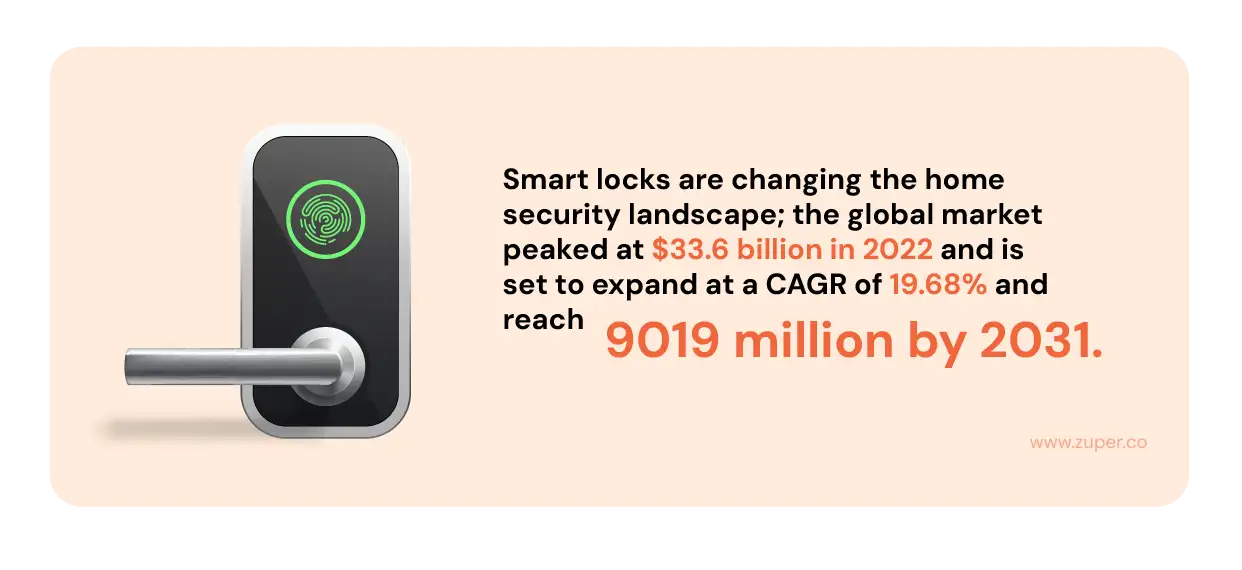
The home security landscape is undergoing an exciting transformation, with smart lock technologies rapidly evolving to deliver unparalleled protection and convenience. Staying informed about the latest advancements will help ensure your home is equipped with the optimal security solution.
Ready to take your home’s safety to the next level? Stay ahead of the curve and safeguard your home with confidence. Don’t miss out on the opportunity to explore how you can implement Zuper’s expertise into your home security business.
Schedule a personalized demo to discuss your unique needs and discover how Zuper can help your home security business fortify your customer’s needs seamlessly. Let’s secure a safer future together, one intelligent lock at a time!
